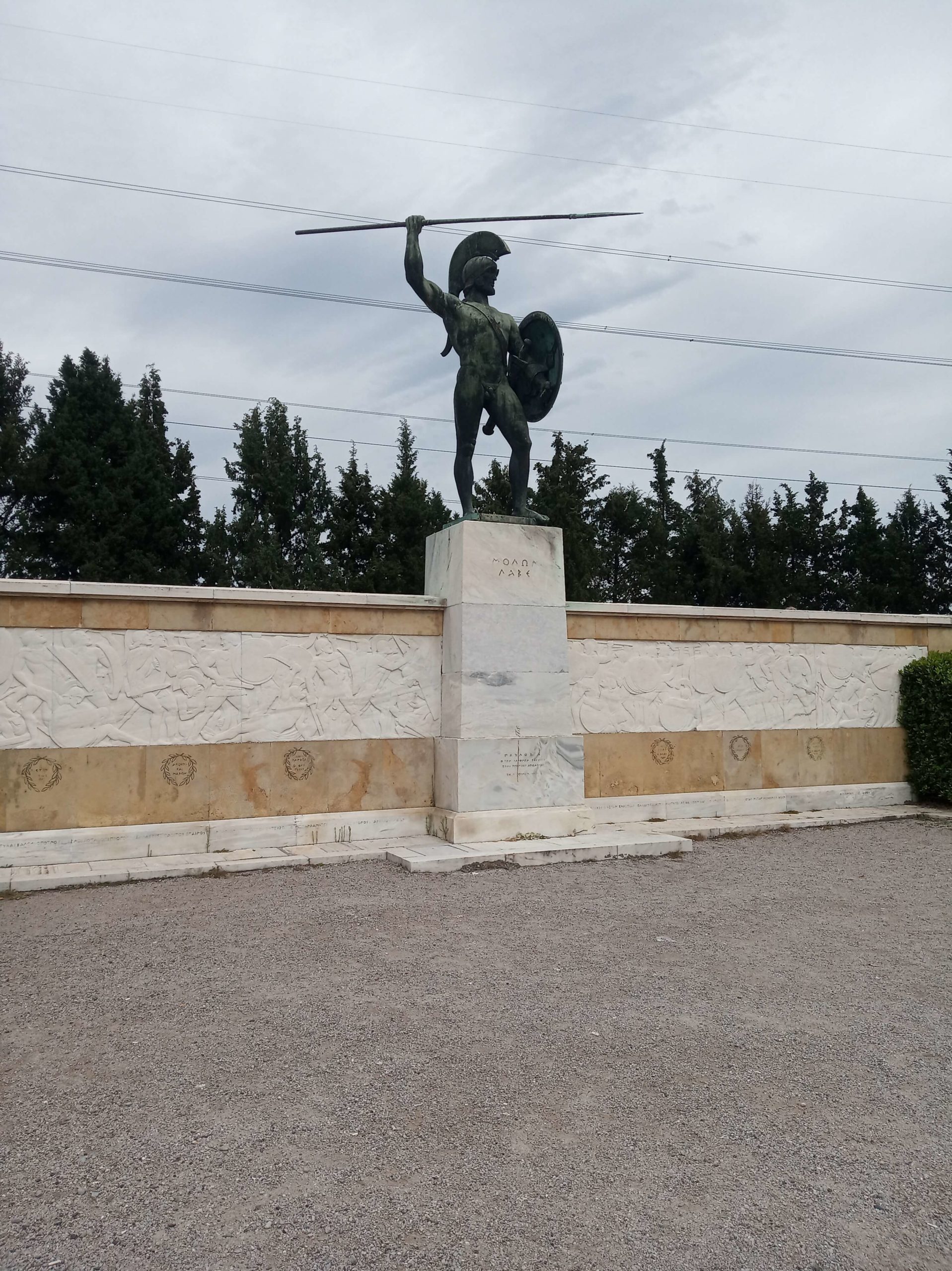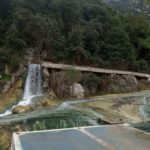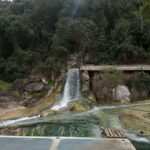Have you ever wondered about the spot where King Leonidas, the Spartan king, met his heroic end? Look no further than Thermopylae, a historic site located on the east coast of central Greece. Situated about 85 miles northwest of Athens, this spot holds immense significance in Greek history. It was here, at the pass of Thermopylae, that a small Greek force under King Leonidas valiantly defended against the mighty Persian army led by Xerxes.
Key Takeaways:
- Thermopylae is the historic spot where King Leonidas died.
- It is located on the east coast of central Greece, about 85 miles northwest of Athens.
- The pass at Thermopylae was the location of the famous Battle of Thermopylae, where the Greeks defended against the Persian army.
- The battle is remembered for the heroic resistance displayed by the Greeks.
- Thermopylae continues to attract visitors due to its historical significance and beautiful natural scenery.
The Battle of Thermopylae: A Historic Stand
The Battle of Thermopylae was a significant event during the second Persian invasion of Greece. Led by Spartan King Leonidas, a small Greek force bravely defended against the advancing Persian army under Xerxes. Taking place in August 480 BCE, the battle lasted for three days and showcased the courageous resistance of the Greeks against overwhelming odds.
The Greek troops, including 300 Spartans, held the pass at Thermopylae, buying valuable time for the Greek fleets at nearby Cape Artemesium to engage the Persian navy. Despite being heavily outnumbered, the Greeks fought fiercely and displayed tremendous bravery. However, they were eventually outflanked by the Persians and suffered heavy losses. King Leonidas and his troops made a last stand, sacrificing themselves for the greater cause.
The Battle of Thermopylae has become legendary and continues to be celebrated as a symbol of heroic resistance. It serves as a testament to the indomitable spirit and unwavering determination of the Greek forces, especially the renowned Spartan warriors. This historic battle remains an enduring example of courage and sacrifice in the face of overwhelming adversity.
“Go, stranger, and tell the Spartans that we lie here obedient to their laws.” – Epitaph of the 300 Spartans
The Battle of Thermopylae: A Historic Stand
| Key Facts | Details |
|---|---|
| Date | August 480 BCE |
| Location | Thermopylae, central Greece |
| Leaders | King Leonidas of Sparta (Greece), Xerxes I of Persia |
| Greek Forces | Approximately 7,000 soldiers, including 300 Spartans |
| Persian Forces | An estimated army of over 100,000 soldiers |
| Outcome | Persian victory, but bought time for the Greeks to regroup and engage the Persian navy |
The Geography of Thermopylae
Thermopylae, also known as the “hot gates,” is a narrow pass located in central Greece. It holds immense historical significance and has been the site of numerous battles throughout history. The pass stretches for about 4 miles and is situated between the Kallídhromon massif and the Gulf of Maliakós. The name “hot gates” comes from the presence of hot sulfur springs in the area, highlighting the unique natural features of Thermopylae.
Over time, the pass has undergone changes, with silting widening the distance between the cliffs and the sea. This geography has made Thermopylae a strategically important location, attracting numerous invasions and battles. The narrowness of the pass and its natural defenses have played a significant role in the military strategies employed by both defenders and invaders.
The Kallídhromon Massif and the Gulf of Maliakós
The Kallídhromon massif, located on one side of the pass, adds to the natural defenses of Thermopylae. This mountain range provided a physical barrier, making it difficult for invading armies to bypass or flank the defenders. The Gulf of Maliakós, on the other side of the pass, added another layer of defense, restricting access to the defenders. These geographic features created a bottleneck effect, forcing armies to funnel through the narrow pass, making it easier for defenders to hold their ground.
| Kallídhromon massif | Gulf of Maliakós |
|---|---|
| Mountain range | Natural barrier |
| Adds to the defense | Restricts access to the defenders |
| Creates a bottleneck effect | Makes it easier for defenders to hold their ground |
Overall, the geography of Thermopylae has played a crucial role in shaping the outcome of battles fought in this region. Its narrow pass, hot gates, and natural defenses have made it a strategically important location throughout history, showcasing the significance of this historic site.
Historic Significance of Thermopylae
Thermopylae holds immense historic significance due to the Battle of Thermopylae and its aftermath. The battle was part of the second Persian invasion of Greece, led by Xerxes. While the Persians ultimately won the battle and conquered central Greece, the Greek resistance at Thermopylae had a profound impact. The heroic resistance displayed by King Leonidas and his troops against the much larger Persian army inspired the Greeks and became a symbol of courage and sacrifice.
The battle also bought time for the Greek forces to regroup and prepare for subsequent battles, ultimately leading to the defeat of the Persian army. The Battle of Thermopylae remains a prominent event in Greek history and has been immortalized in literature and popular culture.
The Heroic Resistance of the Greeks
The Battle of Thermopylae is remembered for the heroic resistance displayed by the Greeks against overwhelming odds. Despite being heavily outnumbered, King Leonidas and his troops fought fiercely, making a last stand and sacrificing their lives for the greater cause. Their bravery and determination inspired future generations and established Thermopylae as a symbol of heroic resistance.
“Their courage and sacrifice at Thermopylae serve as a testament to the indomitable spirit of the Greek people.” – Historian
Impact on Greek History
The Battle of Thermopylae had a significant impact on Greek history. While the Persians ultimately won the battle, the Greek resistance bought crucial time for the Greek forces to regroup and prepare for subsequent battles. This preparation, coupled with strategic alliances, eventually led to the defeat of the Persian army and the preservation of Greek independence.
- The Battle of Thermopylae served as a rallying cry for the Greek city-states, inspiring them to unite and defend their homeland against the Persian invaders.
- The battle highlighted the effectiveness of Greek defense tactics, showcasing the capabilities of the phalanx formation and the determination of Greek warriors.
- The heroic resistance at Thermopylae became a powerful symbol of Greek courage and patriotism, instilling pride and a sense of national identity among the Greek population.
Table: Comparison of Greek and Persian Forces
| Greek Forces | Persian Forces |
|---|---|
| Approximately 7,000 troops, including 300 Spartans | Estimates vary, but likely between 100,000 to 300,000 troops |
| Fought in close formation using the phalanx tactic | Utilized a mix of infantry, cavalry, and archers |
| Defended a narrow pass, utilizing the terrain for strategic advantage | Advanced through a narrow pass, facing challenges in deployment |
| Displayed unwavering bravery and determination | Overwhelmed the Greek forces with their sheer numbers |
Archaeological Discoveries at Thermopylae
The historic site of Thermopylae has been the focus of numerous archaeological excavations, uncovering fascinating artifacts and monuments that shed light on the battle and its aftermath. These discoveries provide valuable insights into the historical significance of Thermopylae and serve as a tangible link to the past.
Monument to the Battle
One of the most notable archaeological discoveries at Thermopylae is the large marble and bronze monument erected in 1955 to commemorate the Battle of Thermopylae. This impressive monument stands as a testament to the bravery and sacrifice of King Leonidas and his troops. Its intricate design and inscriptions serve as a lasting memorial to those who fought and died in the defense of Greece.
“The monument at Thermopylae stands as a symbol of courage and resilience in the face of overwhelming odds.”
Remnants of Ancient Fortifications
The archaeological site at Thermopylae has also revealed remnants of ancient fortifications and structures. These remnants offer valuable insights into the military strategies employed during the battle. They provide a glimpse into the defensive measures taken by the Greek forces, showcasing their resourcefulness and ingenuity in the face of a much larger Persian army.
Insights into Military Strategies
By studying the archaeological remains at Thermopylae, historians and archaeologists have gained a deeper understanding of the military strategies employed by the Greeks. The site has provided evidence of the Greek soldiers’ use of the phalanx formation, a close-knit formation that enhanced their defensive capabilities. These insights shed light on the tactical prowess of the Greek forces and their ability to hold off the Persians for three days.
The Legacy of Thermopylae
The archaeological discoveries at Thermopylae not only contribute to our understanding of the battle but also highlight the lasting legacy of this historic site. The monument to the battle and the remnants of ancient fortifications serve as reminders of the bravery and sacrifice of those who fought in defense of Greece. They provide a tangible connection to the past, allowing visitors to reflect on the significance of Thermopylae and honor the memory of King Leonidas and his troops.
| Archaeological Discoveries at Thermopylae | Highlights |
|---|---|
| Monument to the Battle | Large marble and bronze monument erected in 1955 |
| Remnants of Ancient Fortifications | Unearthed structures providing insights into military strategies |
| Insights into Military Strategies | Evidence of Greek soldiers’ use of the phalanx formation |
| The Legacy of Thermopylae | Reminders of bravery and sacrifice, connecting visitors to the past |
Military Strategies at Thermopylae
The defense tactics employed by the Greeks at Thermopylae played a crucial role in the battle against the Persian invasion. The narrow pass allowed the Greek forces, led by King Leonidas, to effectively block the advance of the Persian army. The Greeks utilized the terrain to their advantage, making it difficult for the Persians to fully deploy their forces.
The Greek soldiers, including the renowned Spartan warriors, fought in close formation known as the phalanx. This formation provided them with enhanced protection and made it challenging for the Persians to break through their defense. The phalanx consisted of heavily armed soldiers standing shoulder to shoulder, with their shields overlapping to create a solid wall. This tactic created a formidable barrier that the Persians struggled to penetrate.
Furthermore, the strategic positioning of the Greek forces at Thermopylae played a crucial role in their ability to hold off the Persian invasion. The narrowness of the pass limited the number of Persian soldiers who could engage in combat simultaneously, giving the Greeks an advantage. The Persians faced challenges in navigating the narrow pass and coordinating their large army, while the Greeks effectively defended their position.
Military Tactics at Thermopylae
The Greek defense tactics at Thermopylae showcased their skillful use of strategic positioning, coordinated formations, and the utilization of natural barriers. These tactics contributed to their ability to resist the Persian invasion for three days, defying overwhelming odds.
“The defense tactics employed by the Greeks were ingenious. Their use of the phalanx formation and the strategic positioning at the narrow pass allowed them to hold off the Persian invasion. This battle serves as an inspiration for military strategists even today.” – Military Historian
Persian Invasion Routes
The Persian invasion routes played a significant role in determining the course of the Battle of Thermopylae. The Persians sought to penetrate Greece through the narrow pass at Thermopylae, which would allow them to bypass the Greek navy and directly attack the heart of the country. However, the geography of the area, with its rugged mountains and narrow pass, provided a natural barrier that the Greeks were able to exploit to their advantage.
By blocking the Persian invasion routes at Thermopylae, the Greeks disrupted the Persian strategy and bought time for their naval forces to regroup and engage the Persian navy. This coordinated defense tactic proved crucial in the overall defense of Greece against the Persian invasion.
| Greek Defense Tactics | Persian Invasion Routes |
|---|---|
|
|
Historical Battles at Thermopylae
While the Battle of Thermopylae is undoubtedly the most famous conflict to have taken place at this historic site, Thermopylae has been the backdrop for several other significant battles throughout history. These battles showcase the strategic importance of the location and the conflicts that have shaped its history.
The Gallic Invasion (279 BCE)
One notable battle at Thermopylae occurred in 279 BCE when the Gallic army, led by Brennus, clashed with Greek forces in the area. The Gallic invasion of Greece posed a threat to the region, and the Greek city-states assembled an alliance to repel the invaders. The battle at Thermopylae was part of this larger conflict and played a crucial role in halting the Gallic advance. The Greek forces, with their knowledge of the terrain and superior tactics, successfully defended the pass and prevented the Gallic army from further advancing into Greece.
Roman-Selucid Wars (191 BCE)
In 191 BCE, Thermopylae became the site of another significant battle during the Roman-Selucid Wars. The Roman general Manius Acilius Glabrio faced off against the Seleucid army at this strategic pass. The battle marked a turning point in the war, as the Roman forces, aided by their superior military organization and tactics, emerged victorious. The Roman victory at Thermopylae helped solidify their control over Greece and demonstrated the effectiveness of their military strategies and discipline.
Greek War of Independence (1821)
Thermopylae also played a role in the Greek War of Independence in 1821. As the Greeks fought to liberate themselves from Ottoman rule, the area around Thermopylae became a site of resistance. Greek fighters, led by Athanasios Diakos, made a stand near the pass to halt the advancing Turkish forces. While ultimately unsuccessful in their defense, their bravery and sacrifice inspired the Greek population and contributed to the overall struggle for independence.
| Battle | Date | Key Players |
|---|---|---|
| The Gallic Invasion | 279 BCE | Greek city-states vs. Gallic army under Brennus |
| Roman-Selucid Wars | 191 BCE | Roman Republic vs. Seleucid Empire |
| Greek War of Independence | 1821 | Greek fighters vs. Ottoman forces |
The Modern Significance of Thermopylae
Thermopylae, the historic site where King Leonidas made his heroic stand against the Persian army, continues to hold immense modern significance. Today, the site attracts visitors from all over the world, drawn by its historical importance and the captivating tales of bravery and sacrifice. Thermopylae has become a must-visit destination for those seeking a deeper understanding of ancient warfare and Greek history.
One of the main reasons for Thermopylae’s modern significance is its appeal to tourists. The archaeological site, with its remnants of ancient fortifications and structures, offers a glimpse into the military strategies employed during the Battle of Thermopylae. Visitors can explore the area and witness firsthand the narrow pass where King Leonidas and his troops made their last stand. It is a chance to walk in the footsteps of history and pay tribute to those who fought and gave their lives for the cause.
“Thermopylae is a living testament to the courage and resilience of the Greeks. It is a place of profound historical interest, where visitors can immerse themselves in the stories of ancient battles and the heroes who fought them.”
– Greek historian, Dr. Maria Papadopoulos
Furthermore, Thermopylae’s natural beauty adds to its allure. With the magnificent Kallídhromon massif as a backdrop and the Gulf of Maliakós stretching before it, the site offers a picturesque setting for visitors to explore and appreciate. The combination of history and stunning landscapes creates a unique and memorable experience for tourists, making Thermopylae a popular destination for history enthusiasts and nature lovers alike.
| Reasons for the Modern Significance of Thermopylae | Benefits for Visitors |
|---|---|
| Historical interest and connection to ancient warfare | Opportunity to explore the battlefield and ancient fortifications |
| Inspiration from stories of bravery and sacrifice | Chance to pay tribute to the heroes of Thermopylae |
| Natural beauty and stunning landscapes | Visually captivating backdrop for exploring the site |
| Cultural and educational value | Deeper understanding of Greek history and the Battle of Thermopylae |
Overall, the modern significance of Thermopylae lies in its ability to captivate visitors with its historical allure and breathtaking scenery. It serves as a poignant reminder of the bravery and sacrifice exhibited by King Leonidas and his troops, and continues to inspire and educate those who venture to this storied location.
Conclusion
Thermopylae, the historic spot where King Leonidas died, holds immense significance in Greek history. The Battle of Thermopylae remains a powerful symbol of heroism and sacrifice, as the Greek forces defended against the invading Persian army. The defense tactics employed by the Greeks showcased their bravery and determination in the face of overwhelming odds.
Thermopylae’s strategic location and natural defenses have made it a site of numerous historic battles throughout the centuries. From the Gallic invasion to the Roman-Seleucid wars and the Greek War of Independence, this narrow pass has witnessed pivotal moments in history. Today, visitors can explore the archaeological site, pay homage at the monument dedicated to the Battle of Thermopylae, and appreciate the breathtaking natural scenery surrounding the area.
Thermopylae serves as a memorial to those who fought and died in the name of freedom, and it continues to attract tourists from around the world. The legacy of King Leonidas and the brave warriors who made their last stand at Thermopylae reminds us of the enduring power of courage and resilience in the face of adversity. This iconic piece of Greek history stands as a testament to the indomitable human spirit and the timeless ideals of heroism and sacrifice.
FAQ
What was the spot where Leonidas died?
The spot where King Leonidas died is known as Thermopylae, located on the east coast of central Greece.
Where is the spot where King Leonidas died?
Thermopylae is located about 85 miles northwest of Athens, on the east coast of central Greece.
What was the Battle of Thermopylae?
The Battle of Thermopylae was a significant battle during the second Persian invasion of Greece, where King Leonidas and his small Greek force defended against the Persian army led by Xerxes.
Who led the Greek forces in the Battle of Thermopylae?
King Leonidas of Sparta led the Greek forces in the Battle of Thermopylae.
What is the geography of Thermopylae?
Thermopylae is a narrow pass located between the Kallídhromon massif and the Gulf of Maliakós in central Greece. It is also known as the “hot gates” due to the presence of hot sulfur springs in the area.
What is the historic significance of Thermopylae?
Thermopylae holds immense historic significance due to the Battle of Thermopylae and the heroic resistance displayed by the Greek forces against the Persian army. It played a crucial role in the second Persian invasion of Greece and ultimately led to the defeat of the Persians.
What archaeological discoveries have been made at Thermopylae?
Archaeological excavations at Thermopylae have uncovered important artifacts, such as remnants of ancient fortifications and structures related to the Battle of Thermopylae. A large monument commemorating the battle was also erected at the site.
What military strategies were employed at Thermopylae?
The Greeks utilized the narrow pass at Thermopylae to their advantage, effectively blocking the advance of the Persian army. They fought in close formation, known as the phalanx, and made it difficult for the Persians to deploy their forces.
Which other historical battles took place at Thermopylae?
Thermopylae has been the site of several significant battles, including clashes between the Gallic army and Greek forces in 279 BCE, the Roman-Selucid wars in 191 BCE, and the Greek War of Independence in 1821.
Why is Thermopylae significant today?
Thermopylae continues to attract visitors from around the world due to its historical significance. The site serves as a memorial to those who fought and died at Thermopylae and offers a glimpse into ancient warfare and Greek history.
What is the significance of King Leonidas’ legacy?
King Leonidas’ legacy symbolizes courage and resilience in the face of adversity. His heroic stand at Thermopylae against overwhelming odds continues to inspire people today.
Source Links
- https://www.britannica.com/place/Thermopylae
- https://en.wikipedia.org/wiki/Thermopylae
- https://en.wikipedia.org/wiki/Battle_of_Thermopylae
Author Profile
-
Welcome to e-thermopyles.gr, your gateway to the fascinating world of Thermopylae and the legendary Spartans. My name is George Margaritis, and I’m the proud owner and writer behind this website.
A Passion for History and the Spartan Legacy
I consider myself fortunate to call the historic site of Thermopylae my home. From a young age, I was captivated by history, and in particular, the incredible tale of the Battle of Leonidas in Thermopylae. The valiant stand of King Leonidas and his 300 Spartans against overwhelming odds has left an indelible mark on the annals of history.
As I delved deeper into this captivating story, my fascination only grew. The bravery, strategy, and sacrifice of those Spartan warriors resonated with me, and I wanted to share this rich history with the world. That’s why I created e-thermopyles.gr, a platform dedicated to exploring and uncovering the depths of knowledge surrounding Thermopylae and the Spartans.
Latest entries
 HistoryOctober 31, 2023Exploring Why is the Battle of Thermopylae Interesting
HistoryOctober 31, 2023Exploring Why is the Battle of Thermopylae Interesting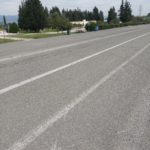 GuidesOctober 31, 2023Your Guide to the Athens to Thermopylae Train Journey
GuidesOctober 31, 2023Your Guide to the Athens to Thermopylae Train Journey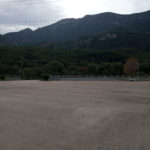 GuidesOctober 31, 2023Uncover the Mystery: Where is Thermopylae Today?
GuidesOctober 31, 2023Uncover the Mystery: Where is Thermopylae Today? GuidesOctober 31, 2023Uncover History by Visiting Thermopylae – A Travel Guide
GuidesOctober 31, 2023Uncover History by Visiting Thermopylae – A Travel Guide
